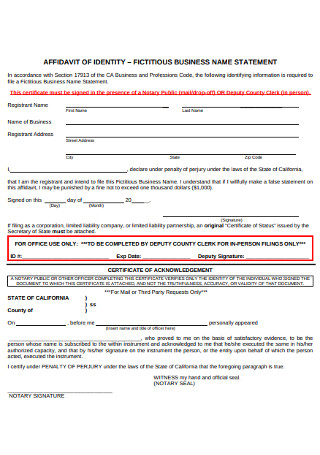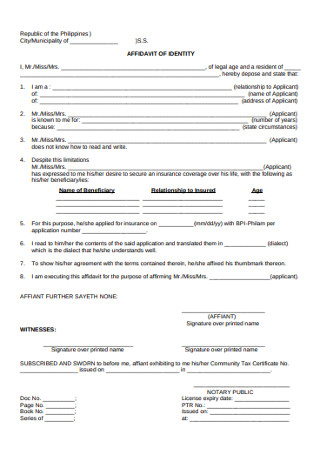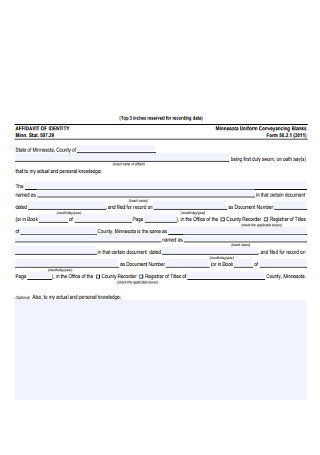23+ Sample Affidavit of Identity Forms
-

Affidavit of Identity Business Statement Form
download now -

Sample Affidavit of Identy Form
download now -

Affidavit of Proof of Identity Form
download now -

Affidavit of Identity Human Service Form
download now -

Affidavit of Identity by Credible Witnesses Form
download now -

Personal Identification of Affidavit Form
download now -

Basic Affidavit of Identity Form
download now -

Identity Theft Notification and Affidavit
download now -

Affidavit of identification Witness Form
download now -

Identity of Affidavit Submit Form
download now -

Student Affidavit of Identity Requirements Form
download now -

Affidavit of Identity and Receipt Filing Form
download now -

Affidavit of Identity Order Form
download now -

Simple Affidavit of Identify
download now -

Affidavit of Identity Business Form
download now -

Formal Affidavit of Identity Form
download now -

Blank Affidavit of Identity Form
download now -

Standard Affidavit of identity
download now -

Formal Affidavit of Identification Form
download now -

Affidavit Proof of Student Identity Form
download now -

Identity Theft Affidavit and Check Forgery Form
download now -

Affidavit of Revenue Department Identity Form
download now -

Identification Card Residency Eligibility Affidavit
download now -

Affidavit of Proof Identitiy Form
download now
FREE Affidavit of Identity Form s to Download
23+ Sample Affidavit of Identity Forms
What is an Affidavit of Identity?
The Constitution of an Affidavit
Supporting Documents for Affidavit
The Pains and Penalties of Perjury
How to Draft an Affidavit of Identity
FAQs
Where can I get an affidavit of identity?
How much is a notarized affidavit?
When does an affidavit of identity expire?
How many ID should I bring for affidavit of identity?
What is an Affidavit of Identity?
A woman from Chicago lost thousands of dollars when a man she has never met before cashed out checks amounting $4,000 from the bank. The puzzling thing was that the signature on the checks was not the woman’s. It was believed that the scammer faked the woman’s ID card and outright deceived the bank tellers. In the US Department of Justice website, the definition of identity theft and fraud are along the lines of deliberate misrepresentation for personal or economic benefit. In the example, the action would not have been permitted if the person was being truthful about his or her identity. To address the severity of such issues, businesses take protective measures a step further by requiring an affidavit of identity from people they are transacting with.
An affidavit of identity confirms and verifies the identity of the person declared in the document. It is a sworn written statement that the information indicated in the affidavit is true and accurate. The document is made upon request of the person whose name, signature, and thumbprint appear on the page. Because of the rampancy of identity theft, several offices request a notarized letters of identity during a transaction. These transactions are those that require the account holder or named person to be the one carrying out actions and decisions. A legal proof of identity protects both the business and the person from impersonators and fraudsters.
The Constitution of an Affidavit
A notarized declaration of a person’s name is not the only ground for the validity of an affidavit. Part of what makes it valid is that it was made on the own volition of the affiant. This means that the person was not under duress, threat, undue influence, or false impression. Aside from that, the document must satisfy the legal requirements, such as what should be contained in its pages. For the written document to be admissible in court, it has to contain the following elements:
Supporting Documents for Affidavit
An affidavit of identity can open many doors. If it is given easily upon anyone’s request in absence of scrutiny, we would lose that protection against identity thieves. In a way, we need proof to gain proof. Before a notary can sign an affidavit, we have to prove that we are the person in the document. Add the following to your checklist of documents to bring before seeing a notary public:
Identification Cards
State-issued identification cards are a sufficient document to present. They should be issued by the federal, state, or local government agencies with high authority. They should still be within its validity period. The card must contain the person’s name, birth date, sex, place of residence, and other descriptive information. These cards also include driver’s license, military, and resident alien identification cards.
Citizen and Foreign Passport
You can also bring your passport and relevant documents with you. The passport should still be valid. If you have a foreign passport instead, it should have a valid United States Visa or I-94 before you can use it as proof of identity. When your passport is issued in a different language, it should be translated into English, and you have to present a Certificate of Accurate Translation.
Other Documents
The identification document has to have your photo, signature, and traceable identification number. In the absence of the first two kinds of documents mentioned, you can bring Department of Homeland Security (DHS) documents, like your US Travel Document I-327 and American Indian Card I-872. Note that the signature you affix on your affidavit must match the signature in your identification document.
What Not To Bring
For security purposes, the notary officer will not accept other identification documents. Therefore, your social security card, school and work ID cards, or marriage and birth certificates will not help you as much in this case. This is because the officer could not satisfactorily verify your identity from these documents. Without the valid documents that sufficiently supports your claim, the officer may not sign your affidavit. For your convenience, you can contact the office that you would go to ask what identification document should you bring for your cause.
If the person who needs the affidavit of identity cannot get the required identification documents because of valid reasons, credible witnesses may verify the person’s identity. The witnesses have to know that person personally but have nothing to gain from the intended use of the affidavit of identity. The witnesses may execute a separate credible witness affidavit that states they know the person and that person does not have the reasonable capacity to obtain the identification documents. This affidavit should explicitly state that the witnesses will not benefit from the activity. Whether this route is possible or not will still depend on the rules and policies of the state.
The Pains and Penalties of Perjury
“Do you solemnly swear that you will tell the truth the whole truth, and nothing but the truth under pains and penalties of perjury?”
What is a law-themed movie without that statement uttered at least once in the entire film? We can see it unfold in our heads: the character seating inside the witness ‘stand’ raises his or her right arm as a court official swears him or her in. Despite the ubiquity of such a scene, not a lot of people understand what those words really mean. Yes, you are not supposed to lie when you are under oath, but what would happen to you if you did?
Former athlete Marion Jones may be among the people convicted of perjury who are wishing that they knew the cost of lying under oath. In the 2000 Olympics, she outran her competitors for the title of the world’s fastest woman the event. She had a promising future in the sports world and outside. However, she was later investigated for using performance-enhancing steroids. She denied this when she was interviewed by federal agents. Although the penalty period can be longer, lying led her to serve six months in jail.
Perjury is a serious offense, and offenders are prosecuted accordingly. Making false statements and fictitious claims under oath qualify as a violation of the function of the law which is to find the truth. The violation also includes not delivering what you swore to deliver or intentionally misleading the authority. The statement of truth in your affidavit maintains that you are accountable for the information you indicate in the document. The statement is your promise to be truthful about the statements in your affidavit. The offense is punishable by fines, probation, or imprisonment, which can be as long as five years. The penalty can vary as to the gravity of the offense.
How to Draft an Affidavit of Identity
You can use the earlier section about what constitutes an affidavit of identity for reference. The following information is a helpful guide on how you can prepare your own document when you need the affidavit for a transaction. That way, you also would not spend a long time in the notary office.
Step 1: Introduce Yourself
Begin the content of your affidavit with an introduction of who you are. Write in the first-person point of view, such as “I, (name, age, citizenship)…”. You can also save some details for the assertions. Use your full name as what appears in your identification documents. If your documents contain errors, like on spelling or symbols, and do not reflect your real name, you might have to settle that problem first. All the details that you would write should reflect your identification materials.
Step 2: Gather your Facts
Start drafting the list of facts that would support your proof of identity. The information should be relevant and significant to making your case that you are the aforementioned person in the affidavit. If there are discrepancies to your identification documents, consider fixing these first as it would inconvenient you more if you keep putting that task off. For example, if you have changed your marital status or moved residence since the time you got your ID, you may have to update your materials first.
Step 3: Download a Template
Instead of starting from zero, you can download a template and modify its content. It helps when you already have a rough sketch on how you would proceed with writing your affidavit. Make sure that the content is appropriate for your use. You can also check with the local authority on what the format of the document should be. The specific structure, headings, and format may vary for different states.
Step 4: Sign Before the Notary Public
Provide a signature block at the last part of your affidavit of identity, but do not sign it yet! You have to affix your signature in the presence of the notarizing officer and witnesses. The notary might refuse a pre-signed document. See the licensed officer first before you pen your signature.
FAQs
Where can I get an affidavit of identity?
You can see your local notary to get an affidavit. They may create the document specifically for you as you wait. They may also provide different affidavit forms that you can fill in.
How much is a notarized affidavit?
A notarized affidavit can set you back around $0.25 to $20, as a standard rate per person. The cost can vary depending on which office and state you would go to. You can inquire from the notarial office or ask your family and friends for recommendations.
When does an affidavit of identity expire?
These documents do not expire. You can use them if you still have them. Although, you may need to get a new affidavit of identity for another purpose. The content of the document can be structured in a way that fits the intended use of the document. Such format of the information may not be the best fit for another intention.
How many ID should I bring for affidavit of identity?
You can bring at least one valid and acceptable identification document. You have to make sure that the document you bring will be accepted by the notary as valid verification of identity. Check in with the office first when you are in doubt,
